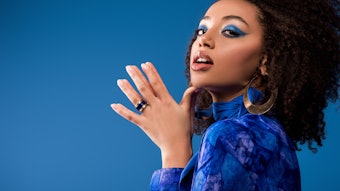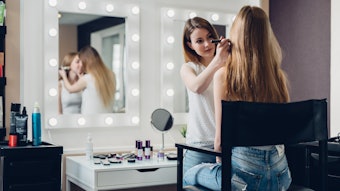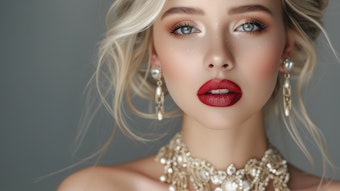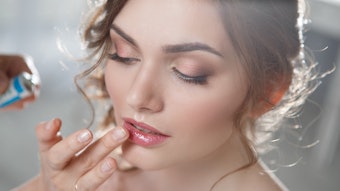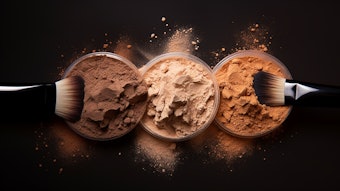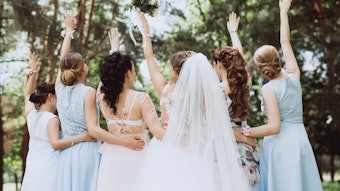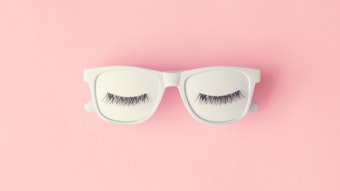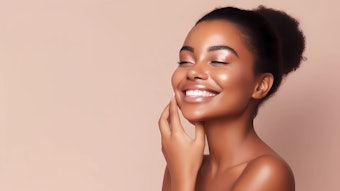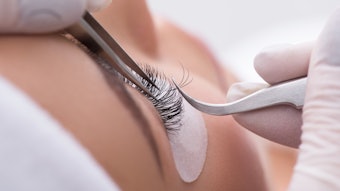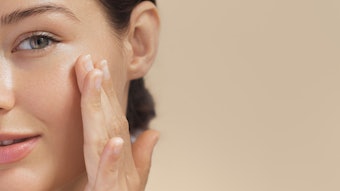In late 2006, while at Planet Blue in Malibu, California, I met a wonderful salesperson who shared with me the latest in makeup technology. I was thrilled to learn that foundation was now being airbrushed on to the skin, and that because of the professional results of the process, the store was unable to keep the aerosol cans of foundation in stock. Their demand was greater than their supply!
I listened as the salesperson explained in detail how the foundation was formulated, why it worked so well and how it left such a flawless finish. She then airbrushed foundation onto me while also instructing me on how to use it. The results, as promised, were spectacular. She matched me for color, suggested a bronzer, and I rolled over like a puppy and said, “Yes.” Ever since that application, I’ve been using airbrush makeup for special occasions and to even out tan lines.
Attending a major cosmetic company party, I again decided to check out the airbrush makeup offerings. This product sprayed out lighter than the other I had bought previously. Enthused once more, I attempted to purchase this product and found it was also low in stock, signifying a troublesome recurring theme. However, as a consolation, I witnessed an airbrushing demonstration where an entire body was airbrushed using a professional compressor complete with portable aerosol can techniques, finishing with an incredible look.
With results—and consumer demand—as exciting as those, spas everywhere are beginning to incorporate airbrush makeup offerings into their own treatment menus. And why not? As long as it is applied onto well-cared for, hydrated skin, airbrushed makeup can appear more natural-looking, stay on longer with a matte finish, and work quite well for special occasions. And in addition to those benefits, by retailing aerosol canisters, a spa can create a new profit stream and cultivate repeat clients through add-on sales. So if you are the first and the best in your area at applying airbrush makeup, your spa has a niche service and an edge on the competition.
The basics
First, though, it is important to get a grasp on the basic terminology that is required to understand the concept of airbrush makeup. Once you build a solid background, it will be easier to understand how to best utilize this service for your spa.
- What is an airbrush? An airbrush is a small, air-operated tool that evenly sprays fluids, such as liquid foundation, and is held in the hand like a pen. The airbrush works in conjunction with a compressor for in-house makeup application and must be attached to the air source in order to spray. The user activates the airbrush by depressing a trigger, which regulates the amount of spray delivered. As the user pulls back on the trigger, a combination of air and fluid are sprayed, creating a look that is very difficult to achieve with a sponge or fingertips.
- What is an air compressor? An air compressor pushes pressurized air to create a moving force. This pressurized air occupies a smaller space inside the compressor or in an air tank connected to the compressor, thereby pushing the liquid foundation through the airbrush so it can be atomized into a fine mist for application onto the skin.
- What is spray can makeup? Spray can makeup performs in the same manner as traditional aerosol cans. A sealed metal can is filled with a propellant as well as a product, such as makeup. The propellant gas is then pumped in at a high pressure, pushing down on the liquid product and dispensing it through the atomizer. Spray cans with an interior plastic tube work in a similar manner with the high-pressure propellant gas driving the liquid product up the plastic tube and out through the nozzle. The narrow nozzle serves to atomize the liquid, breaking it up into tiny drops which form a fine spray.
- Differences. The airbrush and compressor together can provide sustainable, repeatable use, as the tank may be refilled with foundation. Spray can makeup is only good until the product in the can runs out; however, spray can makeup can be sold for retail and is much more portable.
Airbrushing in time
Now, armed with a better understanding of how the technique works, get a look into how airbrush makeup started and how celebrities are using this method to become camera-ready.
The first airbrush was invented in Iowa in 1879 by Abner Peeler for use in painting watercolors and for other artistic purposes. The earliest record of airbrushing being used for makeup application dates back to the 1925 film version of Ben Hur. And though airbrush makeup never really caught on in subsequent years, it has recently re-emerged in a big way.
Airbrush makeup has seen its popularity greatly enhanced with the advent of HDTV, high-definition television with 10 times more picture detail, which can be unforgiving to the person in front of the camera. For this reason, the airbrushing technique is wildly popular in film and TV. Thankfully, gone are the days of pancake makeup that was easily blurred by overhead lighting and lower picture quality.
The airbrush makeup technique is considered something of a godsend among celebrities for the natural appearance it provides while still cleverly washing away scars, discolorations, under-eye circles and other imperfections. Men especially love it because it doesn’t feel like there is anything foreign on the skin, and it has a natural, matte texture. Celebrities who have been known to use airbrush makeup include Jay Leno, Catherine Zeta-Jones, Brad Pitt, Jennifer Lopez, Kelly Ripa, former President Bill Clinton, former Vice President Al Gore and the casts of both Will & Grace and Friends.
Getting down the details
Now to fill in the details on airbrush makeup and cover all the specifics on how the technique works. The airbrush sprays minute dots, or pixels, of makeup at a low psi (pounds per square inch) from the pressurized air flow of the compressor. The airbrush makeup feels like a soft breeze of air going on and dries to a light, matte finish when it comes in contact with the skin. Once applied, it stays on; the makeup is water-resistant, and therefore does not require any touch-ups.
Airbrush makeup is available in an array of colors to suit various skin tones, ranging from very light for fair Caucasians to the darkest brown for black skin and all skins tones in between. Stock foundation colors can also be combined and mixed to achieve the perfect, customized tone for every individual.
Of course, the face and neck are the most common areas of application, but any part of the body can be airbrushed. Foundation is the most common form of makeup applied this way, but blush, eye shadow and self-tanners can also be airbrushed on. In addition, eyebrows or tattoos can be created with an airbrush, using a stencil.
Amy Palma, celebrity makeup artist and the owner of the SoBe Makeup Studio in southern Florida, is a longtime user of airbrush makeup and knows some of its greatest advantages. “The best thing about the airbrush is it delivers long-lasting makeup that stays matte for up to 10 hours. It’s great for a bride or someone with oily skin that may be outside or perspiring,” Palma says. “It stays matte and does not melt down in the heat, and it also will not rub off like regular makeup. That makes airbrush makeup a plus for a bride who will be dancing cheek-to-cheek and hugging and kissing guests. And some artists have a hard time applying foundation evenly for a flawless look. For those artists, the airbrush is mistake-proof as far as delivering a smooth, even finish.”
Another airbrush advantage, according to Palma, is its versatility. “I have also airbrushed to cover stretch marks, spider veins and scars on the body, and it does not and will not rub off on the client’s clothes,” Palma says.
Airbrushing on your own
Airbrush makeup application now can be found on the menu in many finer spas. While the spray can version is available to purchase for every day or occasional home use, in-house makeup applications, usually done with a compressor and airbrush, have become very popular for special occasions and wedding day makeup applications due to its light, natural finish.
There are many brands of aerosol spray makeup available as well. Higher-end cosmetic lines offer aerosol makeup that can be purchased at beauty retailers, spas and salons, and, as a beauty professional, you can easily find a multitude of manufacturers who sell compressors and airbrushes, either on the Internet or through beauty suppliers in your area. Professional start-up kits consisting of a compressor, airbrush pen and hose start at around $400, and a bottle of foundation can be purchased for about $20, with numerous applications per bottle.
Before launching airbrush makeup as a new service offering, though, consider the following suggestions. You may want to utilize a self-contained room for the application process, preferably with suction-type ventilation, to contain any overspray. Be ready to have your artists clean up well after every application, as overspray can quickly build up in a room. And, to make sure the technique is a profitable service, talented and trainable makeup artists are necessary as it takes a steady hand and a great eye in order to do this type of work.
Bringing in the crowds
All that’s left now is getting the word out about the great new procedure you’re offering—and there are several ways to do that. One way would be through well-publicized in-spa promotions or events. You could feature the manufacturer’s representative makeup artist working with your own artist to wow clientele with the technique’s spectacular results.
Business can also be attracted by offering free demonstration applications for local TV personalities, or at bridal fashion shows and beauty pageant contests, where you may collect significant publicity and goodwill for your spa. You may also be able to get a TV news piece done on your new technique if you send out press releases announcing the “Newest, hottest, makeup of the jet-set stars now being offered.” Eventually, good old-fashioned word-of-mouth will take over the initial momentum. Then all you have to do is make sure your staff is ready, your supplies are fully stocked, and you’re ready to start offering this unique service in your own spa.
Airbrush Advanced
The airbrush makeup application technique can be utilized in bringing about these beauty highlights.
- For face glow and body shimmer. Opalescent airbrush colors are available to bring a soft glow or highlight to the skin. It can be used on the face and neck, other exposed body parts or over the entire body.
- To conceal. Foundation can be used to conceal small blemishes or even significant cosmetic conditions such as bruises, birthmarks, razor burn, freckles, or to blend tan lines
- To contour and highlight. Certain areas of the face can be gently highlighted to coax out highlights, while other areas can be contoured by deepening the color, adding definition or drama.
- To create a finish. Airbrush makeup can be applied lightly for a very soft, natural finish or more heavily for a more opaque finish, depending on the desired result. Of course, as an artist, you’ll always want to apply makeup below the chin and jaw line in order to even out the color.
